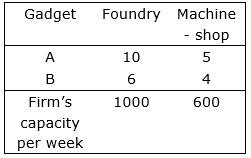A small manufacturing firm produces two types of gadgets A and B, which are first processed in the foundry, then sent to the machine shop for finishing. The number of man - hours of labour required in each shop for the production of each unit of A and B, and the number of man - hours the firm has available per week are as follows:

The profit on the sale of A is Rs 30 per unit as compared with ₹ 20 per unit of B. The problem is to determine the weekly production of gadgets A and B, so that the total profit is maximized. Formulate this problem as a LPP.
The given data can be shown in a table as follows:

Now, let the required weekly production of gadgets A and B be x and y respectively
As it is given that profit on each gadget A is Rs. 30 and that on B is Rs. 20, so profit on x and y number of gadgets A and B respectively are 30x and 20y.
If z = total profit then we have,
z = 30x + 20y
Further, it is also given that the production of A and B requires 10 hours per week and 6 hours per week in the foundry. Also, the maximum capacity of the foundry is given as 1000 hours.
Now, x units of A and y units of B will require 10x + 6y hours
So, we have
10x + 6y ≤ 1000
This is our first constraint.
Given, production of one unit gadget A requires 5x hours per week and y units of gadget B requires 4y hours per week, but the maximum capacity of the machine shop is 600 hours per week.
So, 5x + 4y ≤ 600
This is our second constraint.
Hence, the mathematical formulation of LPP is:
Find x and y which will maximize z = 30x + 20y
Subject to constraints,
10x + 6y ≤ 1000
5x + 4y ≤ 600
and also, as production cannot be less than zero, so x, y ≥ 0